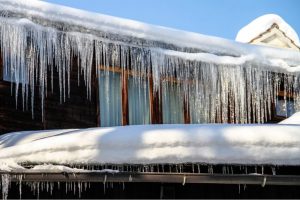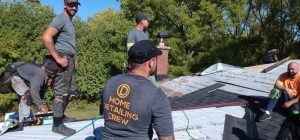How to Safely Remove Snow from Your Roof
Dec 20, 2023

You should keep your roof as snow-free as possible to prevent ice dams from forming. Ice dams can lead to a leaking roof, and subsequent call to a roof repair company.
Snow also weighs a lot. Generally, one square foot of snow that’s one inch deep weighs about a pound. A roof with 12 inches of snow on it could easily amount to thousands of pounds of stress on your roof. If you take ice into account, it gets even heavier. One cubic foot of ice weighs 57 pounds, and a typical ice dam can weigh thousands of pounds. All that strain on your roof can increase the risk of leaking or cave-ins.
When should you do it?
It’s a good idea to clear your roof after every 6 inches of snowfall, but this can vary depending on how heavy the snow is. Wet, heavy snow can weigh 6 or more times as much as lighter, dryer snow. If the snow seems heavy and wet when you pick it up, you may want to get your roof cleared sooner rather than later.
The best way to handle snow removal is by first knowing when it is necessary. Sometimes snow on the roof is harmless, but if the weight becomes too much, it can cause the roof to collapse.
Excess ice can also cause ice dams that will damage most sections of the roof, including the gutters. Some of the factors that can help you determine the right time for snow removal are:
- The pitch of the roof
High pitched roofs are less likely to be affected by snow than shallow-pitched or flat roofs. With low pitches, snow will remain in the same place for longer and continue to accumulate. Even if it melts, the water will remain on the roof and refreeze, adding more weight.
- Snow density
The weight of the snow is usually determined by the accumulation that occurs. Unlike regular snow that is light and fluffy, frozen snow that remains on the roof for long is wet and heavy and should be removed.
- Drifting or uneven distribution of snow on the roof
Snow rarely remains at the same place when it lands on the roof. Wind will push it around, and in most cases, it lands between two slopes or at the intersection between the pitch and the outside walls.
- Knowing how to check for snow overload is also crucial and can be achieved by opening doors and windows. Any door or window that is difficult to open or close could indicate that excess snow is straining the roof structure.
How should you do it?
Sometimes you need your roof snow removed by shoveling, other times by roof-raking. It depends on a number of factors, such as:
- how big your roof is
- how tall your house is
- how much snow your roof received
- how much the snow weighs
Roof-raking is generally best as an ongoing, winter-long task that you can perform as a way of keeping the snow off your roof. In a one-storey home, you can probably use a roof rake to reach most or all of your roof and keep it snow-free. In taller homes, roof-raking is an excellent way to clear the overhangs, which are the weakest part of the roof. It does have its limitations, however. It’s hard to rake any higher than the overhangs in a two-storey home. It’s also harder to clear the snow out of the roof’s valleys, and roof-raking isn’t particularly effective when it comes to wet, heavy, or hardened snow.
Shoveling picks up where roof-raking leaves off. You should probably shovel your roof:
- after a storm drops too much snow for you to remove with a rake
- if the snow is too heavy or hardened for your roof rake
- if your roof is too large or tall for you to be able to rake it
Remove Snow from your Roof: What to do and do not do?
Do it
- When removing snow without professional help, start from the edge of the roof, then move towards the center. Not vice versa.
- The tools used during removal must be carefully selected because metal tools can damage the shingles or any other roofing material used. They can also conduct electricity if they come in contact with power lines.
- Only the tools specifically designed for snow removal should be used because they are better, especially those made of plastic. An example is a snow rake for pitched roofs.
- Emergency exits, fire escapes, and ventilation openings should not have snow blocking them. Drain downspouts should also be clear of snow.
- Contacting a professional to remove the snow is the best way to guarantee the safety of the roof and the people within the vicinity.
Do not do it
- Removing heavy layers of snow is a dangerous process that should not be attempted without relevant experience. If you are not confident in your abilities to handle hardened snow, let a professional take care of it.
- Sharp objects are not ideal for the snow removal process, regardless of how efficient they may appear. They will not do the job properly and may end up damaging other parts of the roof.
- Melting the ice using open flames is a bad idea that should not be attempted no matter what. Electronic devices like hairdryers and heat guns are also dangerous. They will create more ice and add weight to the roof, further threatening the roof’s structural integrity.
- A standard ladder is not efficient during the snow removal process and should not be used. There are special ladders that do not accumulate ice on the rungs and are normally used by professionals. Other specific snow removal equipment like safety ropes are also necessary.
- Stockpiling snow or adding more weight to the roof should only be done after approval by a qualified roofer or engineer.
Raking
It’s important to have the right roof rake. Ideally, it should have small rollers or bumpers on the bottom of the blade that keep it from coming into direct contact with the surface of your roof and scraping the shingles. If you can’t find one with rollers or bumpers, try to get one with a plastic blade, rather than a metal one. Make sure the rake has a slight curve in the handle near the head of the rake; this lets you get a better angle so the rake can cut deeper into the snow. It’s also a good idea to buy extra extension poles with your rake so you can rake as high up as possible on your roof.
The first thing you need to do is to clear the snow off your overhangs. These are the weakest areas of your roof and are the most prone to ice dam formation. From there, work your way up the roof, pulling off a foot or so of snow at a time. Don’t try to pull off too much snow at once. This can cause the excess snow you miss to build up and can slow your progress.
While you rake your roof, watch out for overhead power lines. Remember that you’re essentially waving a giant metal pole in the air, and metal poles and power lines don’t mix.
Shoveling
It’s generally not a good idea to attempt to shovel your roof yourself. However, if you’re absolutely determined, this is how to do it safely and effectively.
First of all, get a shovel with a plastic edge, not a metal one. A plastic edge is less likely to damage your shingles when it scrapes across them. Even so, every time you run a shovel across your roof, you will wear down your shingles a little bit, so try not to do it too often.
While you are on your roof, don’t leave pathways in the snow. Every time you step on snow, you pack it onto your roof. Left alone, these footprint pathways can become ice, and can often form ice dams.
Also, be careful not to dump the snow onto your gas meter. Your gas meter has a little breather hole that, if covered up, will cause your gas to shut off and subsequently shut off the furnace that heats your home.
If you decide to hire a snow-removal service, they generally charge anywhere from $95 to $175 per hour for shoveling. If you have ice dams and need them professionally removed (don’t try to do this yourself!), those services will typically apply their ice dam removal rates to snow removal as well, since ice dams are usually covered in a thick blanket of snow.
If you have any questions about snow removal from your roof or roofing in general please don’t hesitate to call us at (905) 387-3000 or contact us using the contact form on our website. We’d love to hear from you!
Professional Roof Snow Removal Service
Don’t take a chance with your roof if you are not fully equipped to handle snow removal. D’Angelo & Sons have professionals that will come to your rescue, even if you just don’t like the DIY approach. We have been providing these services for decades, and we take pride in doing it the right way at the first trial. With us in the GTA, you do not have to risk your safety or spend the whole winter stressed out. Let our well-trained crew make your winter a hassle-free one with our roofing services. We believe that the successful completion of every job we do determines our success as a company, and we always follow up with our clients after the job is completed. Contact us today for more information.





